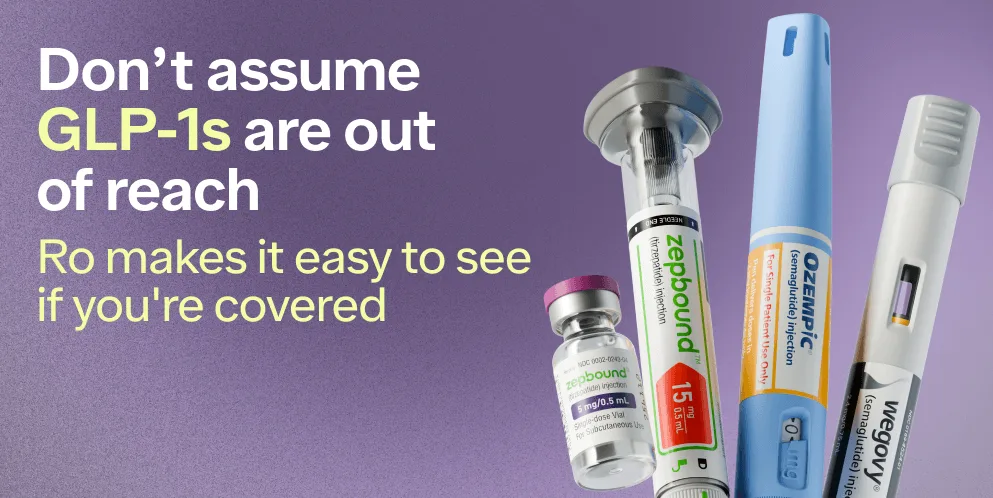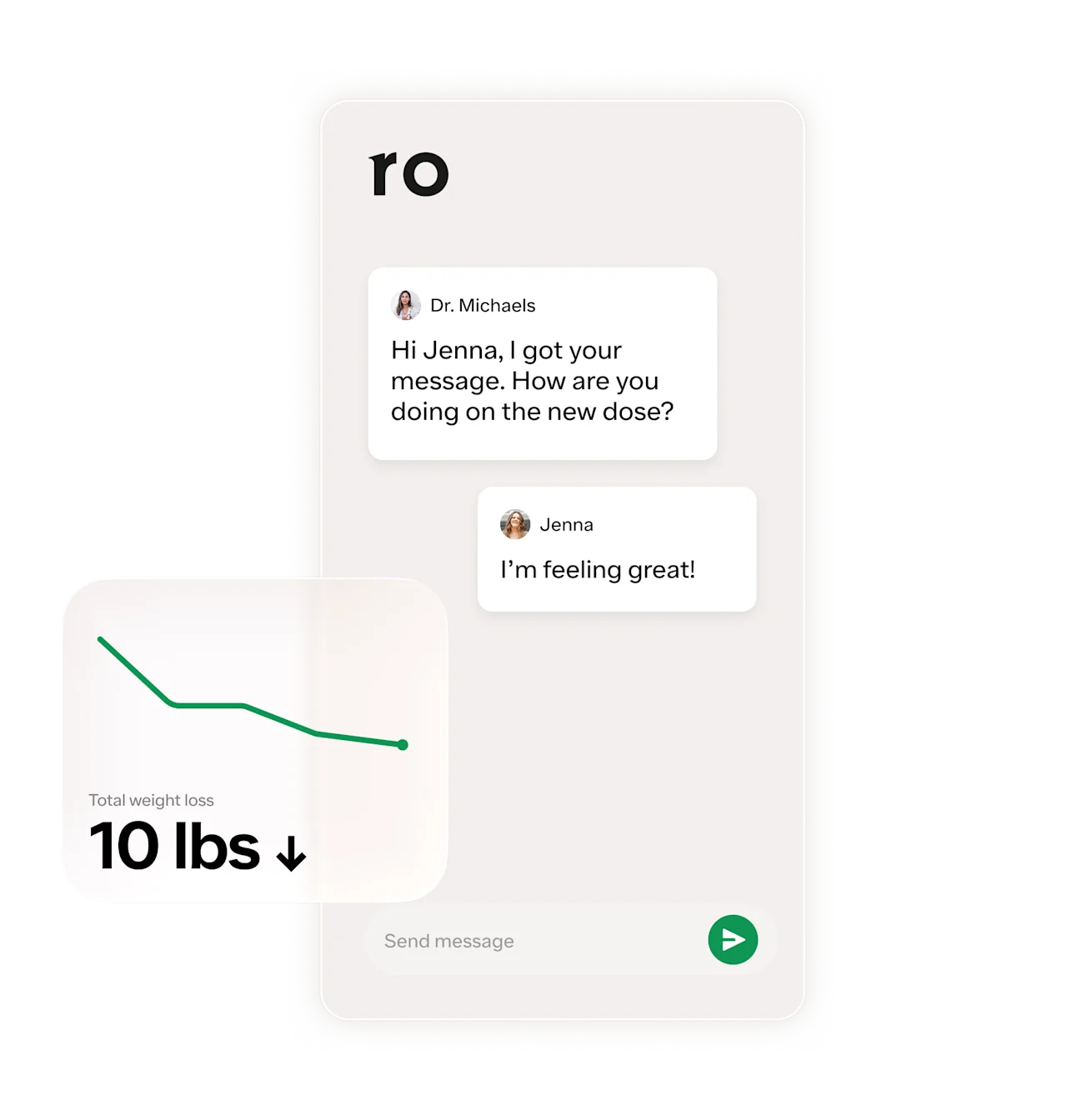Key takeaways
Eating a generally balanced diet can help maximize the effectiveness of Ozempic while minimizing certain side effects.
An ideal Ozempic diet plan should prioritize nutrient-dense foods, such as lean proteins, whole fruits, non-starchy vegetables, whole grains, and healthy fats.
Here's what we'll cover
Key takeaways
Eating a generally balanced diet can help maximize the effectiveness of Ozempic while minimizing certain side effects.
An ideal Ozempic diet plan should prioritize nutrient-dense foods, such as lean proteins, whole fruits, non-starchy vegetables, whole grains, and healthy fats.
Whether you’re taking Ozempic (semaglutide) for an on-label use, such as to manage type 2 diabetes, or off-label, such as for weight loss, you’re likely wondering how to eat in a way that supports your goals—and minimizes side effects. Put simply, you’d like to know the best foods to eat on Ozempic.
While there’s no official Ozempic diet plan, following an overall healthy, nutritious diet can be key to boosting the drug’s effectiveness and seeing desired results. This typically means prioritizing lean proteins, fiber-rich fruits and vegetables, whole grains, and healthy fats. Keep reading to learn more about what to eat on Ozempic, what to avoid, and more.
Is there a recommended Ozempic diet plan?
There is no specific Ozempic diet plan. However, it’s generally recommended to follow an overall healthy eating plan and lifestyle (think: getting regular physical activity) to boost the medication’s effectiveness. In fact, Ozempic is indicated alongside diet and exercise.
Ozempic is approved by the US Food and Drug Administration (FDA) to
Improve blood sugar control in adults with type 2 diabetes
Reduce the risk of major adverse cardiovascular events (e.g. heart attack, stroke) in adults with type 2 diabetes and cardiovascular disease
Reduce the risk of worsening kidney disease and cardiovascular death in adults with type 2 diabetes and chronic kidney disease
As a glucagon-like peptide-1 (GLP-1) agonist, Ozempic mimics a naturally occurring hormone, GLP-1, in the gut. More specifically, it works by stimulating the pancreas to release insulin, signaling the liver to stop releasing stored glucose, and slowing gastric emptying (how fast food moves through your stomach). Together, these effects can help stabilize blood sugar and make you feel fuller for longer, which can lead to reduced caloric intake and ultimately promote weight loss.
Because of how Ozempic affects your digestion and appetite, what you eat while taking it can make a big difference in how well it works—and how you feel.
The best foods to eat while taking Ozempic
The good news is that there aren’t any foods that you have to eat or must entirely avoid while taking Ozempic. Still, Ozempic and other GLP-1 medications will be most effective for weight loss, blood sugar control, and cardiovascular and kidney health when combined with an overall nutritious diet and regular exercise. Not only that, but avoiding foods high in sugar, refined carbohydrates, and unhealthy fats can also help minimize certain side effects of Ozempic.
But let’s begin with the good stuff: the best foods to eat while taking Ozempic.
Lean proteins
An effective Ozempic diet plan starts with prioritizing lean protein. Why? For several reasons, starting with the fact that the macronutrient helps maintain and build muscle, especially when combined with regular, if not increased, physical activity. Preserving muscle mass and supporting muscle growth can help you keep your basal metabolic rate up to burn more calories at rest and, in turn, promote weight loss. It can also help ensure more of the pounds lost come from fat (vs. muscle) mass, according to research.
But weight loss isn’t always the goal with Ozempic—after all, the medication is not even FDA-approved for that purpose. So, another reason why lean proteins are some of the best foods to eat on Ozempic? They take longer to digest, which prevents quick spikes in blood sugar. In the short term, the rapid rise and fall of blood sugar levels can increase hunger and cravings, which may lead to overeating and contribute to weight gain. In the long term, it could increase the risk of diabetes. And for those who already have the condition, research suggests that repeated fluctuations in blood sugar levels can increase the risk of heart disease. By promoting more stable blood sugar levels (thanks to its slower digestion), protein may also help reduce common side effects of Ozempic, such as nausea.
Lean proteins are best, but medium-fat meats can be okay too, says Allison Childress, PhD, RDN, CSSD, LD, an associate professor in the Nutritional Sciences Department at Texas Tech University. Try to add a mix of animal and vegetable protein sources. Examples of lean proteins include:
Seafood
Poultry (e.g. chicken, turkey)
Lean cuts of beef and pork
Beans and legumes
Low-fat dairy products (e.g. cottage cheese and Greek yogurt)
Tofu
The recommended protein intake depends on several factors, including your body weight, age, and activity level. Generally speaking, you should aim for 1 gram of protein per kilogram of body weight while taking Ozempic, says Lauren Aronson RDN, a registered dietitian at Leah Kaufman Nutrition in New York City.
Non-starchy vegetables
Non-starchy vegetables (i.e. those that are lower in carbohydrates) are among the best food groups to add to an Ozempic diet because they’re nutrient-dense. This means they provide lots of essential vitamins and minerals that can help promote satiety and maintain basic bodily functions—all while being relatively low in calories and carbohydrates, which is particularly beneficial for weight loss.
“These are good foods to eat whenever you're eating fewer calories overall because they're really packed with nutrition,” Dr. Childress says. In other words, nutrient-dense items like non-starchy veggies ensure your body gets necessary nutrients even when you’re consuming less food—something that often happens when taking Ozempic.
Thanks to their high-fiber content, non-starchy vegetables can also support weight loss by increasing feelings of fullness without adding many calories. Plus, research shows that starchy, low-fiber vegetables (e.g. potatoes, sweet corn) are more likely to be linked to weight gain, and non-starchy veggies are more likely to be linked to weight loss.
Additionally, non-starchy veggies have a low glycemic index, making them more diabetes-friendly and less likely to cause blood sugar spikes, Aronson says. (In case you’re unfamiliar, the glycemic index measures how fast a carbohydrate-containing food raises blood sugar levels. The lower the carb content—such as in the case of non-starchy vegetables—the lower the glycemic index.)
Try to add a variety of colored vegetables to your diet. Each color represents different nutrients. For example, beta carotene produces the orange pigment seen in carrots and converts to vitamin A by the body. Aim for around 2–3 cups of veggies per day.
Here are a few of the non-starchy vegetables you could include in your diet:
Green, leafy vegetables (e.g. kale, spinach, arugula)
Onions (in modest amounts)
Peppers
Broccoli
Brussels sprouts
Carrots
Celery
Cauliflower
Tomatoes
Asparagus
Whole fruit
Like non-starchy vegetables, whole fruits contain vitamins, minerals, antioxidants, and fiber—all of which are essential for overall wellbeing, especially when taking Ozempic. For starters, the fiber in fruit can help you stay full longer; this can play a key role in promoting not only satiety but also weight loss. In fact, a high-fiber diet has been shown to lower blood sugar, aiding in blood sugar management for diabetes, Dr. Childress says. Plus, the soluble fiber in fruits—i.e. the type of fiber that dissolves in liquid in the gut to form a gel—can help lower cholesterol, too. And this can be particularly important to those taking Ozempic to reduce cardiovascular disease risk.
Over the years, fruits have sometimes been called “bad” for health because they naturally contain sugar, but a 2016 study found that including whole fruits in a balanced diet helps support weight loss and healthy weight maintenance. People with diabetes should consider food’s glycemic index to prevent blood sugar spikes. Some fruits (like apples, berries, peaches, and plums) have a naturally lower glycemic index, making them less likely to cause a blood sugar spike. However, fruit juice or fruit packaged with added sugar will have a higher glycemic index and potentially negatively impact blood sugar levels and weight loss goals.
Try to consume around 1.5–2 cups of fruit per day, preferably mostly fresh fruit, but canned or frozen varieties without added sugar are okay, too.
Here are a few types of fruit that could be included:
Apples
Oranges
Pears
Blueberries
Strawberries
Raspberries
Blackberries
Whole grains
Refined grains, such as white bread and pasta, are typically stripped of most fiber and nutrients during processing. Whole grains, on the other hand, undergo far less processing, leaving them chock-full of nutrients that can help support overall health and enhance the effects of Ozempic.
As complex carbohydrates rich in fiber, whole grains take longer for the body to digest. This helps you feel fuller for longer—an effect that can lead to reduced caloric intake and, ultimately, weight loss. Whole grains’ slow movement through the digestive system also leads to a more gradual release of glucose into the bloodstream, which helps maintain steady blood sugar levels.
On top of its beneficial fiber content, whole grains also contain more protein than refined grains, which is another perk for those on Ozempic, says Brooke Levine, RD, a registered dietitian at the NYU Langone Weight Management Program. Remember: Protein also promotes satiety to help you stay fuller longer and help keep your blood sugar stable.
Adults should try to eat around 45 grams of whole grains per day—something they can do by packing their plates with these smart options:
Beans and legumes
Beans and legumes are excellent plant-based protein sources. Plus, they’re loaded with fiber, potassium, folate, and other nutrients. As mentioned above, the combination of protein and fiber can help support your feelings of fullness, which can make it easier to stick to a balanced diet (read: fewer spikes in blood sugar often mean fewer cravings) and reduce calorie intake.
Some research found that women who consumed more beans had a lower body fat percentage and smaller waists than those with low bean intakes. Plus, if you have diabetes, beans and legumes can be a great choice to help with blood sugar regulation since the fiber and protein in them can decrease blood sugar spikes, Aronson says.
Examples of beans and legumes include:
Black beans
Chickpeas
Navy beans
Dried peas
Edamame
Pinto beans
Lentils
Healthy fats
While they might’ve accumulated a bit of a bad rap over the years, not all fats deserve the shade. In fact, some types of fats—especially unsaturated fats—play a crucial role in supporting brain health, hormone production, and nutrient absorption, making them essential to a balanced diet. When it comes to an Ozempic diet plan, in particular, incorporating unsaturated fats—such as those from nuts, seeds, avocados, and olive oil—can be particularly helpful. That’s because these fats provide long-lasting energy without causing spikes in blood sugar. Plus, they help support feelings of fullness, Aronson says, adding that certain fish can also be good sources of healthy fats.
A 2022 study found eating nuts and seeds was not associated with weight gain or a high body mass index (BMI). It stated that nuts were linked to a lower risk of heart disease, infections, and diabetes. This is especially helpful for those who take Ozempic to manage their diabetes and are at risk for cardiovascular disease.
Here are some healthy fats you might want to include in your Ozempic diet plan:
When consuming fats (even healthy ones), it’s important to consume in moderation to avoid an upset stomach, Dr. Childress says. Not to mention, while nuts and seeds are healthy, they can also be high in calories. She recommends sticking to a serving size of 1/4 cup of nuts or 2 tbsp of nut butter. And because Ozempic in and of itself can cause gastrointestinal (GI) upset, paying attention to your intake of unsaturated fats can help you steer clear of exacerbated side effects and symptoms.
Have you tried any weight loss programs or methods in the past?
Yes, but ready to switch
No, but ready to start
What to avoid eating on Ozempic
Generally, there aren’t any foods that are completely off-limits while taking Ozempic. But limiting your intake of certain bites (and beverages) may help reduce uncomfortable side effects, especially those that affect your GI system (think: nausea, diarrhea, vomiting). In addition to potentially exacerbating side effects, when foods high in saturated fats, refined sugars, and refined carbohydrates are eaten in excess, they can undermine blood sugar control, slow weight loss progress, and counteract other metabolic improvements that Ozempic may offer.
Here, a relatively quick run-through of the foods to limit or avoid on Ozempic:
Fried and greasy foods. These high-fat foods can work against your weight loss goals. Plus, fatty foods naturally slow down gastric emptying, Levine says. Pair this with the slowed gastric emptying effects of Ozempic, and the greasy, fatty food is sitting in your stomach even longer, potentially leading to GI symptoms like nausea or diarrhea, she explains. While some fatty foods are good to incorporate into your diet for their health benefits and ability to improve satiety, those are also best enjoyed in moderation, especially if you are experiencing side effects.
Soda and sugary drinks: “Sugary drinks contain empty calories, calories that don’t fill you up or provide any nutrition,” Aronson says. “Drinking these beverages will work against your weight loss goals.” Not to mention, it’s especially important to avoid these if you have diabetes as “liquid sugars spike blood sugars very high,” she adds.
Acidic or spicy foods: Foods with high acidity are more likely to cause heartburn when you take Ozempic, especially if you’re already prone to gastroesophageal reflux disease (GERD), Dr. Childress says. This is because the acid content is sitting in your stomach for longer.
Refined carbohydrates: Refined carbs are often empty calories, meaning they provide energy (the cals) but little to no nutritional value like fiber, vitamins, or minerals. Plus, since refined carbs have a high glycemic index, they can put you at risk of rapid spikes of blood sugar and insulin levels if you’re diabetic, Dr. Childress says.
Alcohol: Drinking alcohol can increase the risk of GI side effects like upset stomach and nausea, Dr. Childress says. Plus, it’s important to note that when you’re consuming less food than you were before, alcohol might hit you harder, she adds. Lastly, if you’re diabetic, alcohol can have negative effects on blood sugar while taking Ozempic, causing it to drop too low and cause hypoglycemia.
Processed snacks. In addition to trans and saturated fats and high-calorie content, processed products (e.g. chips, cold-cut meats) tend to be high in sodium, as well. “Most Americans consume 3,400 mg of sodium per day, which is almost one and a half times the recommended amount of 2,300 mg,” Dr. Childress says. “Diets higher in sodium are associated with increased risk of developing high blood pressure, kidney disease, stroke and heart failure.” So, if you’re taking Ozempic to help reduce the risk of cardiovascular and kidney disease, it’s best to limit your sodium intake.
Why do some foods trigger side effects on Ozempic?
Ozempic slows down gastric emptying, making food sit in your stomach for longer, Levine says. Although this is what helps you feel fuller longer and potentially promotes weight loss, it also can contribute to developing GI side effects like nausea, vomiting, upset stomach, constipation, or diarrhea, she explains, depending on how your body reacts to the medication. Basically, certain foods that might cause gastrointestinal upset (like fried foods) are even more likely to cause negative GI side effects when you take Ozempic since the food is sitting in your stomach for a longer period before it’s getting digested.
Some people are more sensitive to GI effects than others. “Every person is different, and some people might be able to tolerate the medication without any side effects,” Levine says. “Everything is really case-dependent.”
Other tips to reduce side effects
If you’re struggling with Ozempic side effects, here are some dietitian-approved tips to help you feel better.
Eat more frequent, smaller meals. Instead of focusing on eating three large meals a day, Levine recommends eating more frequent smaller meals. This can prevent you from feeling too full or sick to your stomach.
Drink plenty of fluids. Ozempic may cause some dehydration, so it’s important to drink a lot of fluids and stay hydrated, Dr. Childress says. Drinking a lot of water can also help you combat other potential side effects, such as constipation and headaches.
Try peppermint or ginger tea. Sipping on either of these herbal beverages may help relieve feelings of nausea associated with Ozempic, according to Levine.
Contact your healthcare provider. If the above tips aren’t enough or your side effects aren’t going away or causing significant distress, reach out to your healthcare provider. They may adjust your dosage of Ozempic or offer other suggestions to hopefully alleviate your symptoms. In the case of nausea, for example, your provider may recommend trying an over-the-counter (OTC) treatment, such as Tums or Pepto Bismol, or even prescribe an anti-nausea medication, Levin explains.
Bottom line
Ozempic can be more effective—and more tolerable—when paired with a well-balanced diet. While there’s no official Ozempic diet plan, eating the right foods can help support weight loss, stabilize blood sugar, and reduce common side effects like nausea or diarrhea. Here’s a recap of what to eat while taking Ozempic:
Prioritize lean proteins such as poultry, fish, tofu, and eggs. These help maintain muscle mass, support metabolism, and slow digestion to reduce blood sugar spikes and cravings.
Add plenty of non-starchy vegetables (e.g. broccoli, leafy greens, cauliflower) and whole fruits (e.g. berries, apples) to your plate. Both forms of produce are packed with fiber, which promotes fullness, helps regulate blood sugar, and can even support heart health.
Opt for whole grains such as oats, quinoa, and whole-wheat bread instead of refined carbs, as they contribute to fullness and prevent quick spikes in blood sugar.
Focus on sources of unsaturated (healthy) fats, such avocados, olive oil, nuts, and fatty fish (e.g. salmon) in moderation, and avoid those that are high in trans and saturated fats. The former can provide lasting energy and may reduce cardiovascular risk while the latter can worsen gastrointestinal side effects and counteract blood sugar and weight goals.
Frequently asked questions (FAQs)
What are the best foods to eat when taking Ozempic?
The best foods to eat on Ozempic are healthy, nutrient-packed whole foods. You want to opt for foods that are high in protein, fiber, vitamins, and minerals, such as:
Lean proteins
Non-starchy vegetables
Whole fruit
Whole grains
Beans and legumes
Healthy fats (e.g. nuts, seeds)
How do I get the best results from Ozempic?
You will get the best results from Ozempic by making sustainable dietary and lifestyle changes alongside taking the medication. In fact, Ozempic is approved by the US Food and Drug Administration (FDA) in combination with diet and exercise. This means getting regular physical activity and following a nutritious eating plan are known to promote the effectiveness of the medication. Other tips for maximizing Ozempic include taking care of your mental health (i.e. reducing stress) and getting ample sleep.
Can I eat eggs on Ozempic?
Yes, you can generally eat eggs on Ozempic. Eggs are a good source of protein, which can help you feel fuller longer, support muscle mass, and promote steady blood sugar levels—all of which can enhance the effectiveness of the GLP-1. However, make sure to eat them in moderation if you have high cholesterol, Aronson says.
DISCLAIMER
If you have any medical questions or concerns, please talk to your healthcare provider. The articles on Health Guide are underpinned by peer-reviewed research and information drawn from medical societies and governmental agencies. However, they are not a substitute for professional medical advice, diagnosis, or treatment.
Ozempic Important Safety Information: Read more about serious warnings and safety info.
GLP-1 Important Safety Information: Read more about serious warnings and safety info.
References
Asif, M. (2014). The prevention and control the type-2 diabetes by changing lifestyle and dietary pattern. Journal of Education and Health Promotion, 3, 1. doi: 10.4103/2277-9531.127541. Retrieved from https://pubmed.ncbi.nlm.nih.gov/24741641/
Balakrishna, R., Bjørnerud, T., Bemanian, M., et al. (2022). Consumption of nuts and seeds and health outcomes including cardiovascular disease, diabetes and metabolic disease, cancer, and mortality: an umbrella review. Advances in Nutrition, 13(6), 2136–2148. doi: 10.1093/advances/nmac077. Retrieved from https://www.ncbi.nlm.nih.gov/pmc/articles/PMC9776667/
Cava, E., Yeat, N. C., & Mittendorfer, B. (2017). Preserving healthy muscle during weight loss. Advances in Nutrition, 8(3), 511–519. doi: 10.3945/an.116.014506. Retrieved from https://www.ncbi.nlm.nih.gov/pmc/articles/PMC5421125/
Dreher, M. L. & Ford, N. A. (2020). A Comprehensive Critical Assessment of Increased Fruit and Vegetable Intake on Weight Loss in Women. Nutrients, 12(7), 1919. doi: 10.3390/nu12071919. Retrieved from https://pmc.ncbi.nlm.nih.gov/articles/PMC7399879/
Hanssen, N. M. J., Kraakman, M. J., Flynn, M. C., et al. (2020). Postprandial Glucose Spikes, an Important Contributor to Cardiovascular Disease in Diabetes?. Frontiers in Cardiovascular Medicine, 7, 570553. doi: 10.3389/fcvm.2020.570553. Retrieved from https://pmc.ncbi.nlm.nih.gov/articles/PMC7530333/
Jenkins, D. J., Srichaikul, K., Kendall, C. W., et al. (2011). The relation of low glycaemic index fruit consumption to glycaemic control and risk factors for coronary heart disease in type 2 diabetes. Diabetologia, 54(2), 271–279. doi: 10.1007/s00125-010-1927-1 Retrieved from https://pmc.ncbi.nlm.nih.gov/articles/PMC3017317/
Lee, S. H., Moore, L. V., Park, S., et al. (2022). Adults Meeting Fruit and Vegetable Intake Recommendations - United States, 2019. MMWR. Morbidity and Mortality Weekly Report, 71(1), 1–9. doi: 10.15585/mmwr.mm7101a1 Retrieved from https://pubmed.ncbi.nlm.nih.gov/34990439/
Luhovyy, B. L. & Kathirvel, P. (2022). Food proteins in the regulation of blood glucose control. Advances in Food Nutrition Research, 102, 181-231. doi: 10.1016/bs.afnr.2022.05.001. Retrieved from https://pubmed.ncbi.nlm.nih.gov/36064293/
McRae, M. P. (2017). Health Benefits of Dietary Whole Grains: An Umbrella Review of Meta-analyses. Journal of Chiropractic Medicine, 16(1), 10–18. doi: 10.1016/j.jcm.2016.08.008 Retrieved from https://pmc.ncbi.nlm.nih.gov/articles/PMC5310957/
Meijaard, E., Abrams, J. F., Slavin, J. L., et al. (2022). Dietary Fats, Human Nutrition and the Environment: Balance and Sustainability. Frontiers in Nutrition, 9, 878644. doi: 10.3389/fnut.2022.878644. Retrieved from https://pmc.ncbi.nlm.nih.gov/articles/PMC9083822/
Prasadi, N. P. V. & Joye, I. J. (2020). Dietary Fibre from Whole Grains and Their Benefits on Metabolic Health. Nutrients, 12(10), 3045. doi: 10.3390/nu12103045. Retrieved from https://pmc.ncbi.nlm.nih.gov/articles/PMC7599874/
Reverri, E. J., Randolph, J. M., Kappagoda, C. T., et al. (2017). Assessing beans as a source of intrinsic fiber on satiety in men and women with metabolic syndrome. Appetite, 118, 75-81. doi: 10.1016/j.appet.2017.07.013. Retrieved from https://pubmed.ncbi.nlm.nih.gov/28735851/
Reynolds, A. N., Akerman, A. P., & Mann, J. (2020). Dietary fibre and whole grains in diabetes management: Systematic review and meta-analyses. PLoS Medicine, 17(3), e1003053. doi: 10.1371/journal.pmed.1003053. Retrieved from https://pubmed.ncbi.nlm.nih.gov/32142510/
Sharma, S. P., Chung, H. J., Kim, H. J., & Hong, S. T. (2016). Paradoxical effects of fruit on obesity. Nutrients, 8(10), 633. doi: 10.3390/nu8100633. Retrieved from https://www.ncbi.nlm.nih.gov/pmc/articles/PMC5084020/
Slavin, J. L. & Lloyd, B. (2012). Health benefits of fruits and vegetables. Advances in Nutrition, 3(4), 506–516. doi: 10.3945/an.112.002154. Retrieved from https://www.ncbi.nlm.nih.gov/pmc/articles/PMC3649719/
Soliman, G. A. (2019). Dietary Fiber, Atherosclerosis, and Cardiovascular Disease. Nutrients, 11(5), 1155. doi: 10.3390/nu11051155. Retrieved from https://pmc.ncbi.nlm.nih.gov/articles/PMC6566984/
Tucker, L. A. (2020). Bean consumption accounts for differences in body fat and waist circumference: a cross-sectional study of 246 women. Journal of Nutrition and Metabolism, 2020, 9140907. doi: 10.1155/2020/9140907. Retrieved from https://www.ncbi.nlm.nih.gov/pmc/articles/PMC7294352/
U.S. Food and Drug Administration. (2025). Highlights of Prescribing Information: Ozempic (semaglutide) injection, for subcutaneous use. Retrieved from https://www.accessdata.fda.gov/drugsatfda_docs/label/2025/209637s025lbl.pdf
White, N. D. (2017). Alcohol Use in Young Adults With Type 1 Diabetes Mellitus. American Journal of Lifestyle Medicine, 11(6), 433–435. doi: 10.1177/1559827617722137 Retrieved from https://pmc.ncbi.nlm.nih.gov/articles/PMC6125008/














